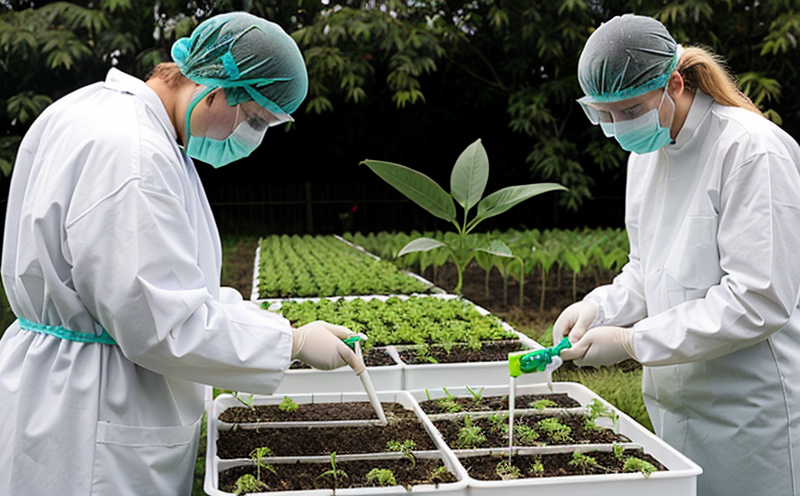Ralstonia Solanacearum (Bacterial Wilt) Testing
Ralstonia solanacearum is a Gram-negative bacterium that causes bacterial wilt, one of the most destructive plant diseases affecting a wide range of crops. This pathogen thrives in warm and moist environments, making it particularly problematic for tropical and subtropical regions around the world. The disease can severely impact crop yield, leading to significant economic losses for farmers and agricultural industries.
The bacterium is known for its rapid spread through soil and plant tissues, especially during irrigation or when water splashes on plants. It affects numerous solanaceous crops such as tomatoes, potatoes, peppers, eggplants, and tobacco. Once the pathogen enters the vascular system of a host plant, it multiplies rapidly, clogs the xylem vessels, and prevents water and nutrient transport to the upper parts of the plant. This results in wilting symptoms that can quickly spread across an entire field.
Early detection and diagnosis are crucial for managing bacterial wilt effectively. Accurate testing helps in identifying infected plants early on, allowing farmers to implement control measures before the disease spreads further. Laboratory testing plays a vital role in confirming the presence of Ralstonia solanacearum through various methods including culture-based isolation, polymerase chain reaction (PCR), loop-mediated isothermal amplification (LAMP), and serological tests.
The choice of diagnostic method depends on factors such as sensitivity, specificity, turnaround time, cost, and availability. Culture-based techniques remain a standard approach but have limitations in terms of speed and detection limits. PCR-based methods offer high sensitivity and specificity, making them highly suitable for detecting Ralstonia solanacearum in field samples.
PCR tests are typically performed using real-time quantitative PCR (qPCR), which allows quantification of pathogen DNA in the sample. This not only confirms the presence of the bacterium but also provides an estimate of its concentration, aiding in assessing the severity of infection and guiding treatment decisions. LAMP is another fast and cost-effective method that can be used for on-site testing, providing results within a few hours.
Sample preparation is critical in ensuring reliable test outcomes. For PCR-based tests, this involves extracting DNA from plant tissues, which requires careful handling to avoid contamination. Extraction kits specific to bacterial pathogens are available commercially, simplifying the process. Following extraction, the sample is ready for amplification and detection using appropriate reagents.
Accurate reporting of test results is essential for effective disease management strategies. Reports typically include identification of the pathogen species (R. solanacearum), quantification if applicable, and recommendations for control measures such as crop rotation, sanitation practices, or chemical treatments. Compliance with international standards like ISO 16140-3 ensures consistency and reliability in reporting.
Given the importance of early detection and management, it is recommended that farmers and agricultural organizations integrate regular testing into their routine practices. This proactive approach not only protects individual farms but also contributes to maintaining regional crop health and sustainability.
Why It Matters
The impact of Ralstonia solanacearum on agriculture is profound, affecting not just the immediate economic value of crops but also long-term soil health and ecosystem balance. In areas where bacterial wilt is endemic, it can lead to reduced crop yields by up to 50%, depending on the level of infection. This translates into substantial financial losses for farmers who rely heavily on these crops.
- Economic Losses: Direct economic impacts include lower market prices due to reduced quality and quantity of produce, increased production costs due to control measures, and potential loss of market access if contamination is detected.
- Socio-economic Impact: Beyond financial losses, the disease can disrupt livelihoods and food security in communities dependent on agricultural exports or local consumption. It also affects employment within the agricultural sector, including laborers and associated service industries.
Bacterial wilt poses a significant challenge to sustainable agriculture practices. The spread of the pathogen through contaminated irrigation water and soil highlights the need for integrated pest management strategies that include testing protocols. By identifying infected fields early on, farmers can implement targeted interventions such as crop rotation, fallow periods, or use of resistant varieties.
Environmental considerations are also important when addressing bacterial wilt. The persistence of Ralstonia solanacearum in soil makes it a persistent threat to future crops even after affected plants have been removed. Therefore, testing and management practices must consider both short-term crop protection and long-term soil health maintenance.
Applied Standards
The accuracy and reliability of Ralstonia solanacearum testing are governed by various international standards that ensure uniformity in methodology and reporting. These include:
- ISO 16140-3:2015 – This standard provides guidelines for the molecular detection of plant pathogens, which is particularly relevant for PCR-based tests used to identify Ralstonia solanacearum.
- ASTM D7879-18 – This ASTM standard outlines procedures for sampling and testing for soil-borne pathogens in agricultural soils, which includes the detection of R. solanacearum.
- EN ISO 20426:2015 – This European standard covers the management of plant health pests including those caused by bacterial pathogens like Ralstonia solanacearum.
Compliance with these standards ensures that testing laboratories adhere to best practices, thereby enhancing confidence in diagnostic results. By following these guidelines, agricultural stakeholders can ensure consistent and accurate identification of the pathogen, facilitating effective management strategies.
Benefits
- Precise Diagnosis: Accurate testing allows for precise diagnosis of bacterial wilt, enabling targeted treatment plans.
- Crop Protection: Early detection helps in preventing the spread of disease, protecting healthy plants and reducing losses.
- Economic Savings: By minimizing crop damage and ensuring high-quality produce, testing can lead to significant savings for farmers and agricultural businesses.
- Sustainability: Sustainable management practices supported by reliable testing contribute to long-term soil health and environmental sustainability.
The benefits of Ralstonia solanacearum testing extend beyond immediate economic advantages. By promoting better crop management practices, testing supports the development of resilient agricultural systems capable of withstanding future challenges posed by plant diseases.





